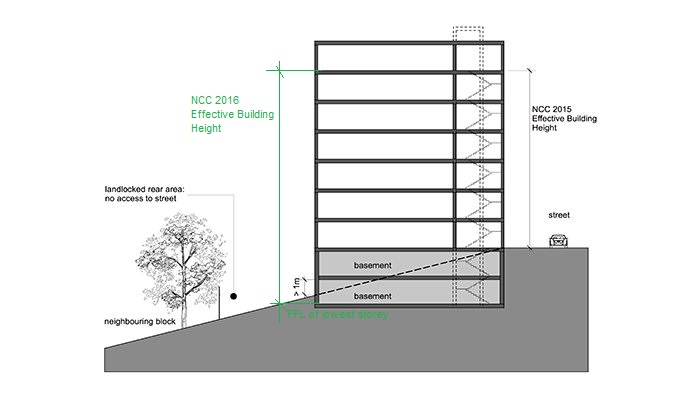With a number of changes occurring with the NCC 2016, one to note is the new definition of effective height.
Under NCC 2015, the effective height of a building is measured from the floor level of the top storey to the ground floor serving the level of egress to a road or open space. However, Under NCC 2016, the effective height is measured from the floor level of the top storey to the floor level of the lowest storey considered in the rise of storeys calculation, i.e. being above natural ground level. Whilst the basement level depicted below may not provide direct egress to a road or open space, it is still considered as being a “rise in storey” due to measuring greater than 1 metre above natural ground level.
The diagram depicts a site which slopes from the front of the building to the rear and how the new definition of effective height will change the height measurement of the proposed building. i.e. from being less than 25 metres under NCC 2015 to greater than 25 metres under NCC 2016 (Source : Credwell Consulting)
This new definition will push many developments over the 25 metre mark which can then require a substantial increase in fire safety systems, including sprinkler systems, stair pressurisation to stairways, emergency lifts, etc. This can add significant costs to the construction of a building.
This new definition will apply to all new developments and new work in existing buildings applied for after 1st May 2016.
NCC 2016 definition of effective height : “the vertical distance between the floor of of the lowest storey included in the calculation of rise in storeys and the floor or the topmost storey (excluding the topmost storey if it contains only heating, ventilation, lift or other equipment, water tanks or similar service units)”
Related Posts
July 28, 2015
The Importance of Protection Works
When building works are in close proximity or directly adjacent to an adjoining property boundary,…
March 12, 2015
The new AIBS brand
The Australian Institute of Building Surveyors has rebranded, with a new website and logo. View the…
November 12, 2015
Application of the DDA
The Disability Discrimination Act makes it illegal to discriminate against a person on the basis of…



